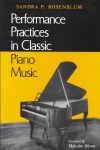
Performance Practices in Classic Piano Music: Their Principles and Applications
Rosenblum, Sandra P.
Indiana University Press. 1988Ficha técnica
- EAN: 9780253206800
- ISBN: 978-0-253-20680-0
- Editorial: Indiana University Press
- Fecha de edición: 1988
- Encuadernación: Rústica
- Dimensiones: 17x23,5
- Idioma: Inglés
- Nº páginas: XXVIII+516
No disponible temporalmente
Disponibilidad sujeta a la información del editorPVP. 45,25€
Añadir a la Lista de deseos
CONTENIDO:
Foreword by Malcolm Bilson
Preface: About performance practices
Acknowledgments
Sources of figures
Introduction: using this book
Abbreviations
I. Background for the study
-Point of view
-Invention and gradual acceptance of the piano
-Some influences on performance
-The musical score
-The composers and their pianism
II. The fortepiano circa 1780-1820
-General characteristics of construction
-Expansion of keyboard compass and instrument size
-Tone and touch
-"Mutations": Hand stops, levers and pedals
-English versus viennese fortepianos
-Four classic composers and their fortepianos
-Instruments played for this study
III. Dynamics and accentuation
-Playing classic period music on a modern grand piano
-Notation and interpretation of dynamic indications
-Repeats
-Evolution of calando and related terms
-Qualitative (dynamic) accents
-Types of accentuation
-Accentuation in Beethoven's music. The annotations to Cramer's Etudes
-An assessment of the annotations to Cramer's Etudes
IV. Use of the pedals
-The damper pedal: introduction
-Types of pedaling
-Stylistic use of the damper pedal
-The development of pedal indications and their ambiguities
-Special effects by Beethoven, Dussek, Clementi, and others
-Adjusting early pedal indications to the pianoforte
-The una corda pedal
V. Articulation and touch
-Introduction
-Nonlegato, legato, and the prolonged touch
-The language of the slur
-Do all slurs indicate attack and release?
-Dot, stroke and wedge
VI. Historial technique and fingering
-Point of view
-Specific functions of technique
-Increasing technical demands
-Fingerings by Clementi and Beethoven
VII. Ornamento
-Introduction
-Appoggiaturas and other one-note ornaments
-Afternote and anticipatory performance of other short ornaments
-The trill
-The mordent
-The turn and the "quick" turn
-The inverted turn
-The trilled turn
-The double appoggiatura
-The slide
-The arpeggio
-Improvised ornamentation
VIII. "Mixed meters" and dotted rhythms
-Mixed meters
-Double-dotting and overdotting
IX. Choice of tempo
-Elements in tempo choice
-The basic tempo groups
-Increasing individualization of tempo
-The metronome
-Six metronomizations of Beethoven's Sonatas
-Fast and "moderate" minuets
-Beethoven's "moderate" minuets: his metronomizations, extrapolated tempos, and present practice
-Extrapolation of other tempos
-Appendix A: Theoretical tempos of Quantz and Türk
-Appendix B: Six sets of metronomizations for Beethoven's piano Sonatas
X. Flexibility of rhythm and tempo
-Introduction
-Rhetorical accentuation by agogic means
-Ritardando and accelerando
-Sectional change of mood and tempo
-Eighteen-Century tempo rubato
-Tempo flexibility as tempo rubato
-Schindler and Czerny on tempo flexibility in Beethoven's piano music
XI. Performing Beethoven's Bagatelle Op. 126, No. 5
-Use of the instrument
-Dynamics and accentuation
-Slurs, articulation, and fingering
-Pedaling
-Tempo choice and tempo flexibility
-Repeat of the middle section
-Critical report
Notes
Selected bibliography
Index
Plates and charts





